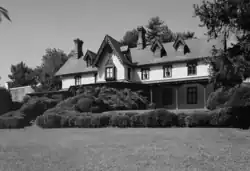Grange Estate
The Grange Estate, also known as Maen-Coch and Clifton Hall, is a historic mansion built by Henry Lewis Jr. (1671–1730) in Havertown, Pennsylvania, near Philadelphia. Parts of the residence are incorporated in the carriage house.
The Grange | |
 The Grange Estate | |
  | |
| Location | 143 Myrtle Avenue, Havertown, Pennsylvania, U.S. |
|---|---|
| Coordinates | 39°58′32.88″N 75°17′4.87″W |
| Area | 9.9 acres (4.0 ha) |
| Built | 1750 |
| Built by | Henry Lewis |
| Architectural style | Gothic |
| Website | https://thegrangeestate.net/ |
| NRHP reference No. | 76001636[1] |
| Added to NRHP | January 11, 1976 |
History
The original tract of land was sold to Lewis by William Penn in 1682. The land was purchased by Captain John Wilcox in 1750, and quickly sold to Charles Cruikshank in 1761. The main house, built in c. 1750 and expanded several times through the 1850s, was, for the most part, built in additions by Cruikshank and his family, who added the various terraces, gardens, and most of the residence facing Cobbs Creek. Cruikshank's son-in-law, John Ross, coined the name 'the Grange' for the property.[2] The building was added to the National Register of Historic Places in 1976 as The Grange.
The mansion, an example of the Gothic Revival style,[3] is presented in the state it was in at the turn of the 20th century. The grounds also feature Victorian gardens.[4][5]
The house was owned by patriot and Philadelphia merchant John Ross during the late 18th century, who named his country estate after the home of Lafayette. Ross's house was frequented by several notable historic figures, including George Washington and Lafayette.[6]
In 1815, the house was purchased by Manuel Eyre Jr.,[7] son of Washington aide Manuel Eyre, who served with Washington during the Revolution. The Eyre family held the estate longer than any other, first from 1815 to 1846, and then, through their Ashhurst cousins, from 1848 to 1911.
The last family to occupy the mansion did so from 1913 until 1974, when the estate was purchased by Haverford Township in 1974 under the Haverford Historical Society.[8]
The mansion is now maintained as a museum and community center. Regular tours are available from April to October and during the December holidays.
References
- "National Register Information System". National Register of Historic Places. National Park Service. March 13, 2009.
- "Haverford Twp. estate to be sold at auction". Delaware County Daily Times. 21 May 1974. p. 12. Retrieved 6 Jun 2023.
- "Fall in PA: Historic Grange Estate". Archived from the original on 2007-09-28. Retrieved 2007-04-03.
- What are some Great Gardens to visit in PA?
- "National Historic Landmarks & National Register of Historic Places in Pennsylvania" (Searchable database). CRGIS: Cultural Resources Geographic Information System. Note: This includes Elizabeth Donaghy and Sally McMurry (July 1970). "National Register of Historic Places Inventory Nomination Form: The Grange" (PDF). Retrieved 2012-01-06.
- The Historic Grange Estate
- H.G. Ashmead, History of Delaware County, p. 578, 1884.
- "Llanerch Women's Club". Delaware County Daily Times. 15 Nov 1974. p. 13. Retrieved 6 Jun 2023.
Further reading
- H.D. Eberlein and H.M. Lippincott, The Colonial Homes of Philadelphia and Its Neighbourhood, J.B. Lippincott Co., Phila. and London, 1912.
External links
- The Grange Estate
- Photograph (1897) at Bryn Mawr College
- Maen-Coch, 200 Grove Place (Haverford Township), Havertown, Delaware County, PA: 8 photos, 4 data pages, and 1 photo caption page at Historic American Buildings Survey

